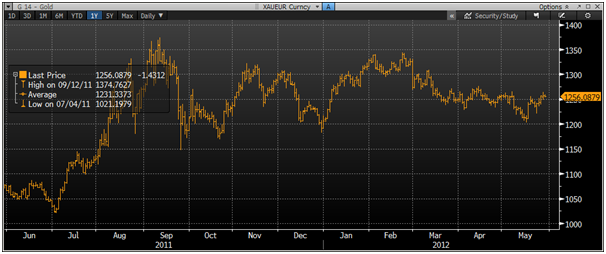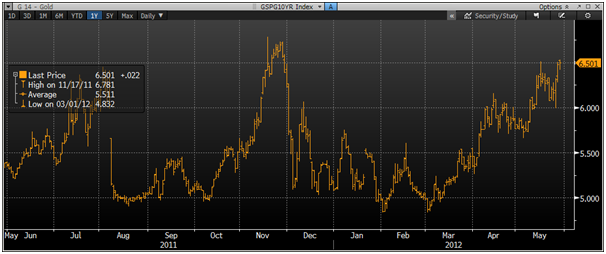Spain’s debt issues are igniting worries about the euro zone's financial stability again, which has sent the euro to a two-year low against the U.S. dollar and is seeing euro gold consolidate over €1,200/oz at €1,257/oz.
Spain’s 10-year interest rates hit 6.53% today as the Spanish economy appears to be collapsing.
Spanish retail sales saw a massive fall in April, dropping 9.8% after March's downwardly revised 3.8% decline. This marked the 22nd straight month of falling retail sales.
Gold is consolidating over $1,500, €1,200 and £1,000 per ounce against the backdrop of spiralling Spanish-debt costs and the growing chance markets are attaching to Greece's exit from the single-currency bloc.
A further sign of China’s importance in the global financial system and in the gold market is seen in the Chinese bank, Industrial and Commercial Bank of China Ltd (ICBC), which wants to join overseas exchanges as it endeavors to become a major global bullion market maker. Shen Shisheng, vice-general manager of financial markets at ICBC told Reuters on the sidelines of a conference in Shanghai that this is exactly their intention.
European policy makers have failed to build a shield strong enough to prevent a bank run in one country from bleeding into others. Again, The risk of a Greek exit is leading policymakers to attempt to create such a shield or buffer according to Reuters.
A push by the ECB for the euro zone to stand behind banks suffering from bank runs is slowly gaining traction but the bloc has yet to build backstops to prevent, or cope with, a sudden collapse of confidence in banks and mass-deposit withdrawals.
Last week, European leaders discussed pan European means of supporting banks, measures the ECB hopes will include a bank resolution fund to deal with the fallout from the windup or restructuring of a failing bank.
But a wave of withdrawals by depositors -- either for fear that their government is too weak to stand behind its banks or that their country will exit the euro and forcibly convert their savings into a vastly devalued national currency -- would represent a crisis of completely new proportions.
Greece’s exit and reversion to its national currency, the drachma, could precipitate electronic bank runs in other periphery nations. The risk is that even savers who believe their banks to be safe, conclude that there is a risk their euro deposits may, in the event of a sovereign crisis, be forcibly converted to drachmas, pesetas, liras, punts and escudos.
OTHER NEWS
(Bloomberg) -- ETF Securities Gold ETPs Had Biggest Inflows Since December.
ETF Securities Ltd.’s long gold exchange-traded products had $240 million of inflows last week, the most since December, the company said in a report e-mailed today.
(Sydney Morning Herald) -- Platinum: So Rare Total World Production To Date Would Fit Inside An Average Size Living Room
Mention precious metals and people's minds go immediately to gold. But platinum is even more valuable than the yellow metal and its value is driven by both decorative an industrial usage. Platinum is so rare that total world production to date would fit inside an average size living room.
Tens of tonnes of ore must be mined and put through a five-month refining process to make one ounce of the metal. South Africa accounts for 80% of world production followed by Russia and North America.
It is chemically inert, so it never loses its rich, white lustre. As a result, it is highly sought after by the jewellery trade, which accounts for 51% of annual production. The remainder goes into various industrial uses. Investors can get exposure to platinum on the U.S. Nymex futures market or on the Australian Securities Exchange through an exchange-traded fund coded ETPMPT. 
Platinum trade was fairly subdued for the two decades leading up to 2003 with the precious metal locked in a tight trading range of $268.60 and $573.60 per troy ounce. Mark Umansky, a certified financial technician and councillor with the Australian Technical Analysts Association, observes that the platinum market first attempted to break out of this long-term trading range in September 2000 at point 1 on the chart. However, the rally failed and the price fell back into its old range, finding support at the 50% level, or mid point (point 2) of that range, a recognised support level in technical analysis.
Then late in 2002, international buyers went confidently into the market and pushed it through the old ceiling at point 3 on the chart.
Technical-analysis theory says that when prices convincingly break out from a long-term trading range, the first target they should reach is a doubling of the magnitude of the old trading range, known as the 100-percent line, point 4 on this chart.
When platinum achieved this early in 2004, it encountered some resistance before the climb continued to point 5, or 200% of the old trading range.
There again, resistance saw a brief fall but the bulls were well and truly in the market pushing platinum to record highs of $2234.90 an ounce at point 6, or almost 500%, in June 2008.
However, sellers then entered the market pushing the price down more than 66% in six straight months of decline. When the price reached point A, close to the initial breakout signal at point 4, it stabilised at about $752.10 and began to rise, this time a little more gradually.
The market went into a consolidation phase at the beginning of the ring on the chart and moved slowly to a distribution phase when informed investors started to sell, taking their profits just above the rising trend line at point B.
Now the market is poised delicately. Should it fall through point B, the next support will be at the trend line. If that is broken, a further support would be at point A. Conversely, Umansky says, strong support at point B could see platinum test its previous highs.
- English (UK)
- English (India)
- English (Canada)
- English (Australia)
- English (South Africa)
- English (Philippines)
- English (Nigeria)
- Deutsch
- Español (España)
- Español (México)
- Français
- Italiano
- Nederlands
- Português (Portugal)
- Polski
- Português (Brasil)
- Русский
- Türkçe
- العربية
- Ελληνικά
- Svenska
- Suomi
- עברית
- 日本語
- 한국어
- 简体中文
- 繁體中文
- Bahasa Indonesia
- Bahasa Melayu
- ไทย
- Tiếng Việt
- हिंदी
Spanish Bank Runs Continue To Worry
Published 05/29/2012, 09:25 AM
Updated 07/09/2023, 06:31 AM
Spanish Bank Runs Continue To Worry
Latest comments
Loading next article…
Install Our App
Risk Disclosure: Trading in financial instruments and/or cryptocurrencies involves high risks including the risk of losing some, or all, of your investment amount, and may not be suitable for all investors. Prices of cryptocurrencies are extremely volatile and may be affected by external factors such as financial, regulatory or political events. Trading on margin increases the financial risks.
Before deciding to trade in financial instrument or cryptocurrencies you should be fully informed of the risks and costs associated with trading the financial markets, carefully consider your investment objectives, level of experience, and risk appetite, and seek professional advice where needed.
Fusion Media would like to remind you that the data contained in this website is not necessarily real-time nor accurate. The data and prices on the website are not necessarily provided by any market or exchange, but may be provided by market makers, and so prices may not be accurate and may differ from the actual price at any given market, meaning prices are indicative and not appropriate for trading purposes. Fusion Media and any provider of the data contained in this website will not accept liability for any loss or damage as a result of your trading, or your reliance on the information contained within this website.
It is prohibited to use, store, reproduce, display, modify, transmit or distribute the data contained in this website without the explicit prior written permission of Fusion Media and/or the data provider. All intellectual property rights are reserved by the providers and/or the exchange providing the data contained in this website.
Fusion Media may be compensated by the advertisers that appear on the website, based on your interaction with the advertisements or advertisers.
Before deciding to trade in financial instrument or cryptocurrencies you should be fully informed of the risks and costs associated with trading the financial markets, carefully consider your investment objectives, level of experience, and risk appetite, and seek professional advice where needed.
Fusion Media would like to remind you that the data contained in this website is not necessarily real-time nor accurate. The data and prices on the website are not necessarily provided by any market or exchange, but may be provided by market makers, and so prices may not be accurate and may differ from the actual price at any given market, meaning prices are indicative and not appropriate for trading purposes. Fusion Media and any provider of the data contained in this website will not accept liability for any loss or damage as a result of your trading, or your reliance on the information contained within this website.
It is prohibited to use, store, reproduce, display, modify, transmit or distribute the data contained in this website without the explicit prior written permission of Fusion Media and/or the data provider. All intellectual property rights are reserved by the providers and/or the exchange providing the data contained in this website.
Fusion Media may be compensated by the advertisers that appear on the website, based on your interaction with the advertisements or advertisers.
© 2007-2024 - Fusion Media Limited. All Rights Reserved.
